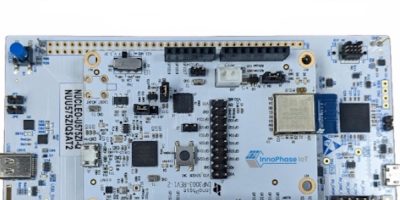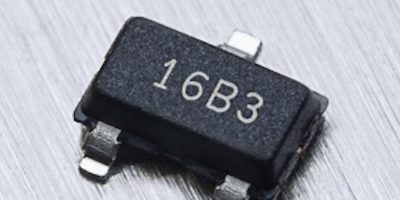Two spatial computing platforms called Snapdragon XR2 Gen 2 and Snapdragon AR1 Gen 1 have been introduced by Qualcomm to enable the next generation of mixed reality (MR), virtual reality (VR) devices and smart glasses.
Wearable
Evaluation board delivers “lowest power sensor-to-cloud IoT solution”
Fabless semiconductor company, InnoPhase IoT has integrated STMicroelectronics’ STM32U5 microcontroller in its InnoPhase IoT Talaria TWO Wi-Fi/ Bluetooth Low Energy evaluation board. According to the company, it enables more than 10 years of battery life for a variety of applications.
Resistor equipped transistors are compact for wearable devices
A double space saving is provided with the 500mA resistor equipped transistors (RETs) said Nexperia. They integrate bipolar junction transistors and resistors in a single package to enable high-power load switching in space constrained applications.
The 12 RETs are in compact DFN2020(D)-6 packaging and designed for load switching in wearables and smartphones as well as for use in digital circuits with higher power requirements, such as space constrained computing, communications, industrial and automotive applications.
The RET in DFN configuration achieves dual space-saving feats, said Nexperia. Firstly, integrating the bipolar junction transistor (BJT) and resistor into a single package offers substantial board space savings and secondly, the leadless DFN packaging contributes to space savings.
The RETs deliver the specified 500mA output current from a tiny DFN2020(D)-6 package measuring only 2.0 x 2.0 x 0.65mm. This packaging is particularly suitable for thermal performance in high power applications, delivering up to 1W total output power from collector-emitter voltages (VCEO, open base) up to 50V.
Micropower switches extend batteries for IoT
Two low power Hall effect switches, the MLX92216 and MLX92217, have 1.0 microwatt power consumption and narrow tolerances for a predictable power budget, helping to extend battery runtime, said Melexis.
These magnetic devices detect open or closed positions and can replace traditional reed switches in IoT and industrial or white goods.
The growing demand for smart devices to be battery-powered but long lasting is a challenge for IoT. The need for low power components which are both reliable and accurate is paramount, said Melexis.
The MLX92216 and MLX92217 microwatt switches are three-wire monolithic magnetic switches which are claimed to deliver industry leading accuracy, consistency and reliability throughout the lifetime of the application. Unipolar, omnipolar and latch variants are available, making the device suitable for applications such as lid close/open detection, wearables, industrial machines, appliances, tablet cases, valves, energy and flow meters, while also serving as a replacement for traditional proximity and reed switches.
The switches have an integrated logic for automatic sleep/awake sequencing enabling 0.9 microA average current consumption with no action necessary from the user (depending on the model variant). The MLX92217 has an ‘enable’ pin that allows users to activate or deactivate the automatic sleep logic, driving the standby current consumption down to 200nA whilst still ready to be woken up by the system. Paired with min/max tolerance variation (less than 50 per cent), these devices provide a stable power budget and longevity, including peak current consumptions of less than 1.5 microA.
About Weartech
This news story is brought to you by weartechdesign.com, the specialist site dedicated to delivering information about what’s new in the wearable electronics industry, with daily news updates, new products and industry news. To stay up-to-date, register to receive our weekly newsletters and keep yourself informed on the latest technology news and new products from around the globe. Simply click this link to register here: weartechdesign.com







